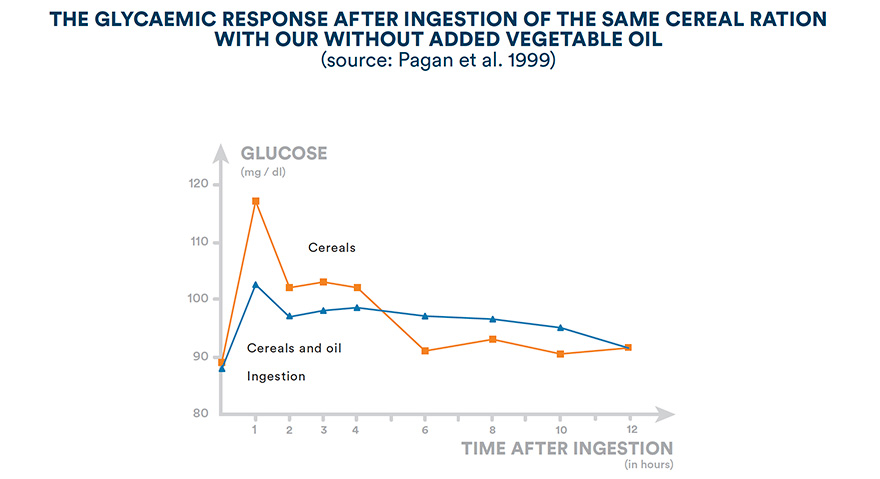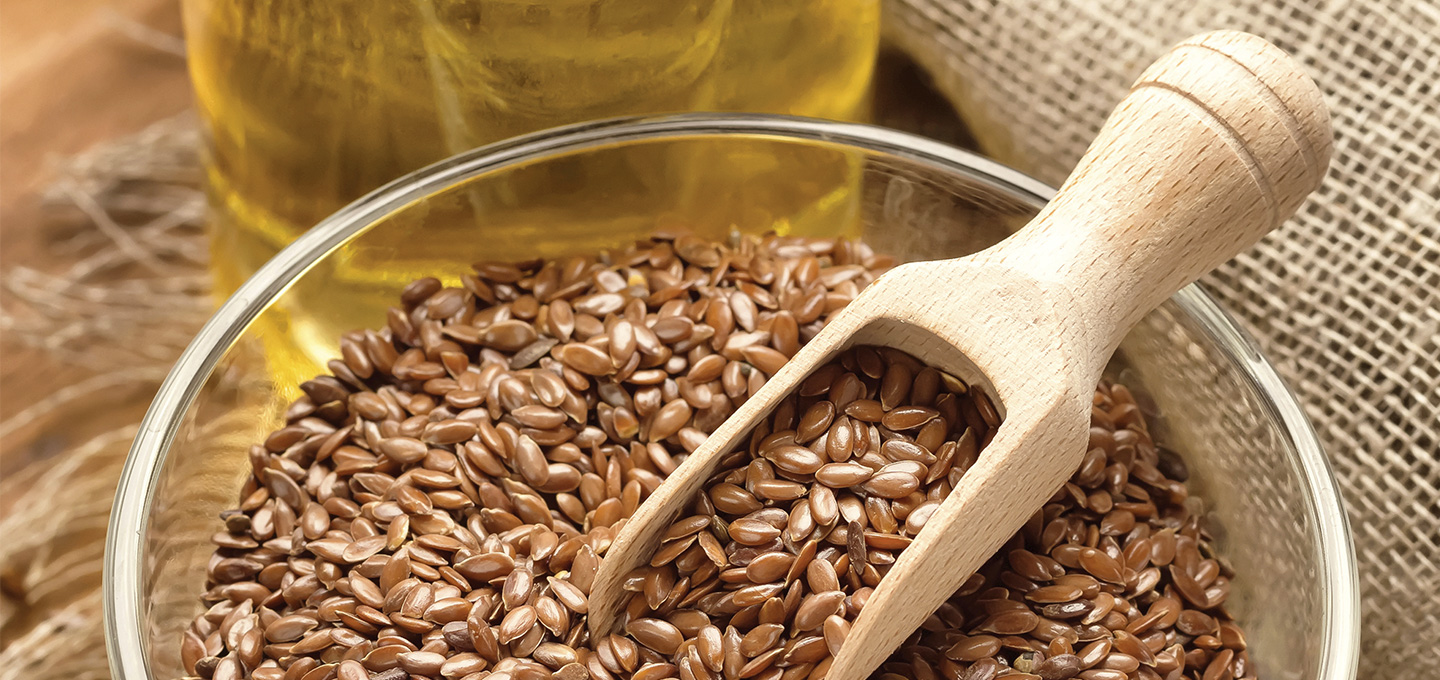Definition
Lipids are insoluble in water but soluble in organic solvents.
We can distinguish two principal groups :
- Saturated fatty acids (ex: palmitic acid) : These are above all present in solid fats (butter, lard, etc.) and in certain oils (palm oil, coconut oil, etc.).
- Unsaturated fatty acids : These are in general constituents of oils. Amongst them are different families:
- Monounsaturated fatty acids, such as Omega 9 fatty acids (oleic acid) present in large quantities in hazelnut, olive and rape-seed oils.
- Polyunsaturated fatty acids (PUFAs).
- Omega 3 fatty acids: Found in large quantities in linseed oil (linolenic acid) and in fish oils or in certain seaweeds in the form of superior derivatives (DHA, EPA).
- Omega 6 fatty acids (acid linoleic etc.): Found in large quantities in Grape seed, sunflower, corn and soya oils.
Nutritional interests
Oils and fats represent a less versatile energy source than starch. They can only be oxidised aerobically to produce energy, or stored in the form of body fat (above all saturated fatty acids). Effectively Fatty acids cannot be converted into glucose or used to synthesise glycogen.
However, oils and fats do present numerous nutritional interests.
Energetic density
Oils and fats are very high in energy. Thus, they increase the energetic density of a ration allowing the provision of sufficient energy in a limited volume of food.
In energy terms, 1 litre of vegetable oil corresponds to approximately 3 kg of barley.
Muscular metabolism
The use of lipids in the ration permits:
- A sparing of a part of muscular glycogen notably in type I fibres. Sparing muscular glycogen is interesting because it delays the appearance of tiredness.
- To reduce heat production (caloric losses) in the muscle cells because the conversion of oil into mechanical energy is more efficient than with carbohydrates.
Therefore, oils and fats are an interesting energy source for horses undertaking prolonged efforts during hot and humid weather such as during endurance events. However, despite this, it is important to provide the horse with a sufficient quantity of starch in his diet, even for those effectuating long distance efforts. Otherwise we expose them to early depletion of their muscular glycogen reserves.
Omega 3 and Omega 6 sources
Like some amino-acids, they cannot be synthesised by the organism from where comes their name of « essential » fatty acids. Essential structural components of the cell membranes, they condition the permeability and functional qualities of biological membranes. Their transformation within the organism results in terminal products, prostaglandins.
These hormones have properties that are more or less beneficial:
- The two groups result in beneficial prostaglandins with anti-inflammatory, immunostimulating and hypocholesterolemic properties.
- However, Omega 6s also engender harmful prostaglandins with pro-thrombotic, pro-inflammatory, pro-allergic and immunosuppressive properties.
Therefore, to obtain an overall beneficial effect on the health it is important to provide in the total ration at least as many omega 3s as omega 6s.
Glycaemic index
Providing lipids reduces the glycaemic index of the ration (see the graph) in several ways:
- For a given energy value the incorporation of lipids reduces the cereal part of the ration.
- Increasing the energetic density by the use of oil reduces feed size. Thus affecting digestion time and the glycaemic response in the sense of a diminution of the glycaemic index.
- The presence of lipids in the small intestine stimulates the production of a hormone, the cholecystokinin (CCK). This hormone reduces the motility of the stomach and so delays the emptying of the stomach contents, thus influencing the duration of transit and the extent of pre-caecal starch digestibility.

Consequently, providing fats and oils is interesting for horses suffering from pathological conditions related to and/or aggravated by high glycaemic indexes: obesity, behavioural problems, chronic myopathies, gastric ulcers, Cushing’s disease, equine metabolic syndrome and laminitis.
Oils and fats represent a less versatile energy source than starch.
Supply recommendations
Wolter (1999) recommends ceilings on the lipid content in a ration to maximums of:
- 5 - 7 % for racehorses.
- 10 - 12 % for endurance horses or those suffering from metabolic disorders directly related to carbohydrates (« tying-up »).
For endurance horses, it would even be preferable to limit oils and fats in the concentrated ration to 8% (source: Goachet, 2010).
Furthermore, to avoid all excessive storage, which would contribute to clogging up the organism, it is unadvisable to feed lipids rich in saturated fatty acids such as palm oil, copra oil etc.
Which lipid sources to choose?
>Unlike green forage (grass and lucerne) that contain about twice the number of omega 3s than omega 6s, cereals contain a majority of omega 6s. Therefore, it is important to re-establish an omega3/omega6 ratio beneficial to the good health of the organism, (greater than or equal to 1).
Thus, all our feeds are composed using extruded linseed, rich in natural omega 3s (linolenic acid), and the richest feeds in oils and fats also include linseed oil, which has the highest level of omega 3 of all oils on the market.
More than any other constituent, oils must be of irreproachable quality. To achieve this, several points must be respected during their production process:
- Extraction: We have chosen a cold extraction, first pressed (mechanically) « food quality » linseed oil. This extraction technique allows the oil to keep its nutritional qualities. It has not been subjected to chemical solvents and/or high temperatures as is the case for refined oils. Thus, the risk of altering the fatty acids and the other natural components (natural vitamin E, phytosterols, etc.) is minimised.
- Conservation, storage: It is recommended to store the oils away from air and light in hermetic containers. Equally, it is preferable to add anti-oxidants to protect the unsaturated fatty acids from oxidation (denaturation).
If these conditions are not respected, we risk the oils becoming rancid with a denaturation of the unsaturated fatty acids. These latter are very toxic for the organism.
The necessities of antioxidant cover (vitamin E)
A supply of lipids in the ration necessitates higher requirements of antioxidants, notably vitamin E, even though this fat-soluble vitamin is already partly present in vegetable oils. Indeed, vitamin E acts as a membrane antioxidant. It captures peroxide free radicals produced by the oxidation of unsaturated fatty acids following an oxidative stress. Thus, dietary requirements in antioxidants are related to the richness in polyunsaturated fatty acids (PUFAs) and the endogenic level of vitamin E of oils.
As for Vitamin E, we recommend of 0.6 to 0.8 mg (or IU) per gram of total PUFAs or, 3 mg per gram of acid linolenic (WOLTER, 1999). In the knowledge that REVERDY feeds provide on average 300 mg / kg of vitamin E, rations based on our feeds provide very secure antioxidant coverage for your horse.




